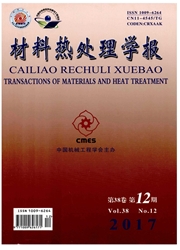

 中文摘要:
中文摘要:
Electrical steel sheets with 6.5%(mas fraction) Si with good shapes and superior magnetic inductions were successfully produced by a specially designed processing route including ingot casting, hot rolling and warm rolling both with interpass thermal treatment, and final annealing. The sheets were of 0.2 mm and 0.3 mm thick over 140 mm width. A detailed study of the microstructural and textural evolutions from the hot rolling to annealing was carried out by optical microscopy, X-ray diffraction and electron backscattered diffraction. The hot rolled sheet characterized by near-equiaxed grains was dominated by the mixture of <001>//ND fiber(λ-fiber), <110>//RD fiber(α-fiber) and <111>//ND fiber(γ-fiber) textures owing to the partial recrystallization and strain induced boundary migration(SIBM) during the hot rolling interpass thermal treatment. The static recovery and SIBM during the warm rolling interpass thermal treatment result in large and elongated warm rolling grains. The warm rolling texture is dominated by obvious λ, Goss and strong γ-fiber textures. The application of the interpass thermal treatment during hot and warm rolling significantly enhances the impact of SIBM during annealing, which is responsible for the formation of the moderate λ-fiber, some near-λ fiber texture components and the obviously weakened γ-fiber texture in the annealed sheet, leading to a higher magnetic induction compared to the commercially produced 6.5% Si steel by chemical vapor deposition(CVD).
 英文摘要:
英文摘要:
Electrical steel sheets with 6.5%(mas fraction) Si with good shapes and superior magnetic inductions were successfully produced by a specially designed processing route including ingot casting, hot rolling and warm rolling both with interpass thermal treatment, and final annealing. The sheets were of 0.2 mm and 0.3 mm thick over 140 mm width. A detailed study of the microstructural and textural evolutions from the hot rolling to annealing was carried out by optical microscopy, X-ray diffraction and electron backscattered diffraction. The hot rolled sheet characterized by near-equiaxed grains was dominated by the mixture of 〈001〉//ND fiber(λ-fiber), 〈110〉//RD fiber(α-fiber) and 〈111〉//ND fiber(γ-fiber) textures owing to the partial recrystallization and strain induced boundary migration(SIBM) during the hot rolling interpass thermal treatment. The static recovery and SIBM during the warm rolling interpass thermal treatment result in large and elongated warm rolling grains. The warm rolling texture is dominated by obvious λ, Goss and strong γ-fiber textures. The application of the interpass thermal treatment during hot and warm rolling significantly enhances the impact of SIBM during annealing, which is responsible for the formation of the moderate λ-fiber, some near-λ fiber texture components and the obviously weakened γ-fiber texture in the annealed sheet, leading to a higher magnetic induction compared to the commercially produced 6.5% Si steel by chemical vapor deposition(CVD).
 同期刊论文项目
同期刊论文项目
 同项目期刊论文
同项目期刊论文
 Characterization of microstructure, texture and magnetic properties in twin-roll casting high silico
Characterization of microstructure, texture and magnetic properties in twin-roll casting high silico Microstructure, texture and magnetic properties of strip-cast 1.3% Si non-oriented electrical steels
Microstructure, texture and magnetic properties of strip-cast 1.3% Si non-oriented electrical steels Influence of the finish rolling temperatures on the microstructure and texture evolution in the ferr
Influence of the finish rolling temperatures on the microstructure and texture evolution in the ferr Texture evolution and formability under different hot rolling conditions in ultra purified 17%Cr fer
Texture evolution and formability under different hot rolling conditions in ultra purified 17%Cr fer Through-thickness shear strain control in cold rolled silicon steel by the coupling effect of roll g
Through-thickness shear strain control in cold rolled silicon steel by the coupling effect of roll g Development of strong {001} texture and magnetic properties in Fe-6.5wt.%Si thin sheet produced by r
Development of strong {001} texture and magnetic properties in Fe-6.5wt.%Si thin sheet produced by r Microstructure and texture evolution of strip casting 3 wt% Si non-oriented silicon steel with colum
Microstructure and texture evolution of strip casting 3 wt% Si non-oriented silicon steel with colum 期刊信息
期刊信息
